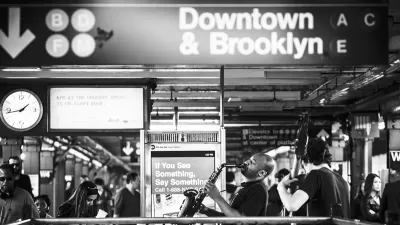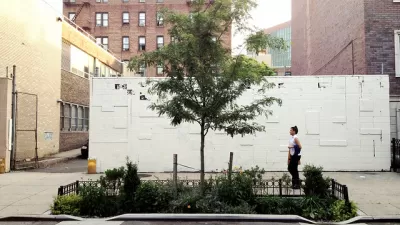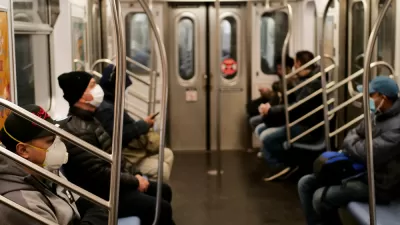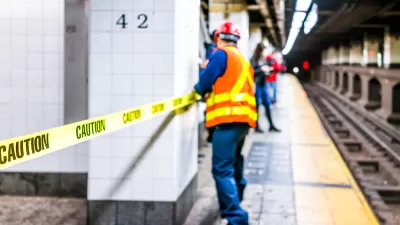While the New York subway's need for infrastructure investment is well documented, it was an improperly placed rail that caused two subway cars to derail on a southbound A train on Tuesday morning in Harlem.

The Metropolitan Transportation Authority "is now checking rails across the system to make sure replacement parts are being properly stored," report Jonathan Wolfe and Emma G. Fitzsimmons for The New York Times in one of several articles on the June 21 derailment.
The accident, which left at least 34 people injured [Planetizen put the number at 37] took place between the 135th Street and 125th Street stations. Two cars jumped the tracks after the emergency brakes were activated, officials said.
Human error was also the cause of a derailment almost two decades ago, on July 3, 1997, that occurred on the A Train line injuring 13 passengers and two firefighters.
A southbound A train jumped the track as it passed through 135th Street station at St. Nicholas Avenue. A worker who was fixing the switches at the station had accidentally flipped a switch for the wrong track.
The derailment added a new dimension to the concerns of the almost six million weekday commuters who rely on the nation's largest subway. "Until Tuesday, the main concern for riders had been long and unpredictable delays in a fraying system," report Fitzsimmons and Marc Santora in an earlier piece. "But in a flash, the concern shifted from inconvenience to questions about basic safety."
While human error was the cause of these two derailments, aging equipment in the 112-year-old system is causing delays plaguing every line. However, "it is not the No. 1 reason," report Fitzsimmons, Ford Fessenden, and K.K. Rebecca Lai in a related article.
The major cause of subway delays is a factor that basically did not exist 15 years ago: overcrowding. The subway is a victim of its own success and the city's resurgence. Large crowds slow down trains, which creates more crowding in a vicious circle that takes hours to unwind during every rush.
The article has a chart showing delays attributed to overcrowding, track maintenance, and signal failures or other track problems. The reporters chronicle the increase in subway ridership, which has reached "the highest level since the 1940s."
FULL STORY: New York Today: Derailment Answers and Your Commute

Maui's Vacation Rental Debate Turns Ugly
Verbal attacks, misinformation campaigns and fistfights plague a high-stakes debate to convert thousands of vacation rentals into long-term housing.

Planetizen Federal Action Tracker
A weekly monitor of how Trump’s orders and actions are impacting planners and planning in America.

San Francisco Suspends Traffic Calming Amidst Record Deaths
Citing “a challenging fiscal landscape,” the city will cease the program on the heels of 42 traffic deaths, including 24 pedestrians.

Defunct Pittsburgh Power Plant to Become Residential Tower
A decommissioned steam heat plant will be redeveloped into almost 100 affordable housing units.

Trump Prompts Restructuring of Transportation Research Board in “Unprecedented Overreach”
The TRB has eliminated more than half of its committees including those focused on climate, equity, and cities.

Amtrak Rolls Out New Orleans to Alabama “Mardi Gras” Train
The new service will operate morning and evening departures between Mobile and New Orleans.
Urban Design for Planners 1: Software Tools
This six-course series explores essential urban design concepts using open source software and equips planners with the tools they need to participate fully in the urban design process.
Planning for Universal Design
Learn the tools for implementing Universal Design in planning regulations.
Heyer Gruel & Associates PA
JM Goldson LLC
Custer County Colorado
City of Camden Redevelopment Agency
City of Astoria
Transportation Research & Education Center (TREC) at Portland State University
Jefferson Parish Government
Camden Redevelopment Agency
City of Claremont





























